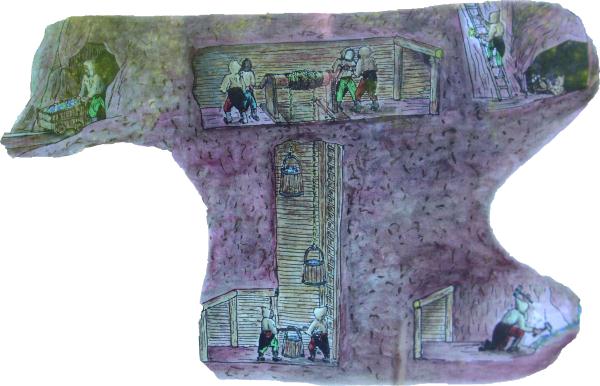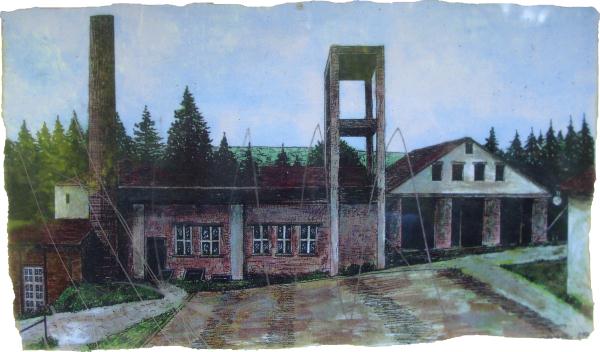Bergwerk Neubulach EarthCache
-
Difficulty:
-

-
Terrain:
-

Size:  (other)
(other)
Please note Use of geocaching.com services is subject to the terms and conditions
in our disclaimer.
|
 Bergwerk Neubulach Bergwerk Neubulach
|
|

Entstehung des Erzvorkommen in Neubulach
Der Erzbergbau im Nordschwarzwald hat seine Grundlage in der Tiefe des Erdinnern. Unter dem Schwarzwald, am Übergang zwischen Granit und Erdmantel, lösten sich in den Wasseranteilen des Granits die im Magma enthaltenen Mineralien. Diese standen aufgrund der Tiefe unter großem Druck und hoher Temperatur.
Als der Rheingraben zwischen den sich aufwölbenden Gebirgen Schwarzwald und Vogesen aufbrach wurden in der Tiefe auch Klüfte und Spalten aufgerissen.
Durch diese Risse konnten die Mineraldämpfe nach oben steigen. Dabei nahmen Druck und Temperatur ab und die mineralischen Bestandteile der Dämpfe wurden ausgefällt. Sie schieden sich an den Wänden der Klüfte ab. Ein großer Teil der Spalten füllte sich so allmählich mit verschiedenen Mineralien: Es entstanden die sogenannten Erzgänge.
Die Neubulacher Erzgänge führten als Hauptmineral vorwiegend Baryt (Schwerspat) und Quarz (Bergkristall). Daneben enthielten sie aber auch andere Bestandteile, die im Mittelalter als Erze gefördert wurden. Das Interesse der Bergleute galt vor allem dem silber- und kupferhaltigen Wismutfahlerz und dem blauen Azurit, einem Kupfermineral.
Zwei der Neubulacher Erzgänge reichten bis an die Oberfläche.
|
|

Die erste Phase des Bergbaus in Neubulach
Um ca. 800 begann die Besiedlung der Hochfläche um Neubulach als Teil des Landesausbaus in der Karolingerzeit. Schon bald nach dem Bebauen des Landes dürfte das Vorhandensein von Bodenschätzen entdeckt worden sein.
In Neubulach wurde etwa ab dem Jahr 1000 Bergbau betrieben. Die Bergleute konnten die Bodenschätze in Schürfgruben und Pingen (Mulden) direkt erreichen.
|
|

Der Aufschluss unter Tage
Ab der ersten Hälfte des 13. Jahrhunderts verlagerte sich der Bergbau in Neubulach unter Tage. Dies war erst durch das Lösen des Entwässerungsproblems möglich. Im Tagebau standen Pingen immer wieder unter Wasser. Nach 1200 wurde ein erster Wasserlösungsstollen angelegt, der vom Ziegelbachtal her zu den Erzgängen aufgefahren wurde.
|
|

Der Niedergang des Bergbaus in Neubulach
Ab ca. 1500 verlor der Neubulacher Bergbau stark an Bedeutung. Die reichen Vorkommen an Silber und anderen Edelmetallen in der Neuen Welt verdarben die Preise in Europa. Zudem wurde der Abbau in Neubulach mit zunehmender Tiefe immer aufwändiger und die Erzgänge waren zum größten Teil ausgebeutet.
Zuletzt wurde nochmals in den Jahren nach 1920 unter Tage gearbeitet.
In den 30er und 40er Jahren entstand der Plan einer Wiederaufbereitung der auf der Hochfläche befindlichen Halden.
Im Mittelalter konnte das im Erz enthaltene Wismut nicht verwertet werden. Es hat sich über Jahrhunderte im Haldenmaterial angesammelt. Die bereits fertiggestellten Anlagen wurden vor ihrer Inbetriebnahme nach dem 2. Weltkrieg demontiert.
|
|

Die Atemwegstherapie im Hella-Glück-Stollen
Seit 1972 werden in einer neu angelegten Therapie-Station medizinisch betreute Anwendungen durchgeführt.
Die Speläotherapie (Höhlentherapie) in Neubulach ist vorzüglich geeignet zur Behandlung von Atemwegserkrankungen, vor allem dem Asthma bronchiale. Daneben wird auch die Heilbehandlung zahlreicher Allergieformen zunehmend wichtig werden.
|
|
Weitere Informationen über den Hella-Glück-Stollen und die Öffnungszeiten
| April bis Oktober |
|
| Montag |
Ruhetag |
| Samstag, Sonntag und Feiertage |
11:00 – 16:00 |
| Vor- und Nachsaison Dienstag bis Freitag |
14:00 Führung |
| Juli und Schulferien Dienstag bis Freitag |
11:00 – 16:00 |
| Dauer: |
etwa 45 min |
| Erwachsene: |
4,50 € |
| Schüler: |
2,50 € |
| Kinder ab 4: |
1,00 € |
|
|
Um die Fragen zu beantworten und den Cache zu loggen muss man das Bergwerk nicht besichtigen. Dies ist allerdings sehr interessant und empfehlenswert.
|
|
Um diesen Cache loggen zu dürfen, musst du folgende Aufgaben erledigen:
Auf dem Weg vom Parkplatz zum Eingang des Stollens findest du einige Informationstafeln. Diese werden dir helfen die Fragen zu beantworten. Bitte sende eine Mail an Antwort1Antwort2Antwort3@gmail.com. Ihr bekommt in den nächsten Minuten eine Antwort mit der Logfreigabe. Falls nicht sendet bitte eine Mail an mein Profil.
Macht ein Bild von euch und / oder eurem GPS am Stolleneingang und fügt dieses Bild eurem Log zu.
Fragen:
1. in welchem Zeitalter brach der Rheingraben auf?
2. welche Eisenverbindung verleiht dem Buntsandstein seine charakteristische rote Farbe (Die Lösung steht in der Klammer, chemische Formel).
3. Eigenschaft der Luft im Therapiestollen (das komplette Wort in den Anführungszeichen, 9 Buchstaben).
|
|
 Mine Neubulach Mine Neubulach
|
|

The origin of the ore deposits in Neubulach
The ore mining in the northern Black Forest is based on the deep interior of the earth. Below the Black Forest - at the crossing of granite and the mantle of the earth – the water contents of the granite dissolved the minerals in the magma. Due to their depths they were under severe pressure and high temperature.
When the Rhine rift broke open between the bulging mountains of the Black Forest and the Vosges, in the depths fissures and crevasses were torn.
The mineral vapour could rise up through the cracks. Pressure and temperature declined, and the mineral components were precipitated. They were separated at the walls of the crevasses. Many crevasses were filled gradually with diverse minerals: So-called metalliferous lodes emerged.
The metalliferous lodes consisted mainly of barytes (heavy spar) and quartz (rock crystal). In addition they contained other components that were extracted as ore in the Middle Ages. The main interest of the miners lay on fahlore from bismut containing silver and copper, and the blue azurite, a copper containing mineral.
Two of the metalliferous lodes in Neubulach reached the surface.
|
|

The first phase of mining in Neubulach
Around 800 began the settlement of the plateau surrounding Neubulach. Soon after the first development of the grounds the existence of the mineral resources have probably been discovered.
In Neubulach, mining was carried on since approximately the year 1000. The miners could directly reach the mineral resources through mining pits and glory holes.
|
|

The exposure below ground
Since the first half of the 13th century mining in Neubulach moved below ground. This was made possible by solving draining problems. The glory holes were often filed with water. After 1200 a first drainage gallery was laid out, that drifted up from the valley of Ziegelbach to the metalliferous lodes.
|
|

The decline of mining in Neubulach
Approximately since 1500 the mining in Neubulach lost its significance. The rich deposits of silver and other precious metals in the New World spoiled the prices in Europe. In addition the mining in Neubulach became more costly and difficult with increasing depth. Besides, the metalliferous lodes had been widely exploited.
In the end, in the years after 1920 work below ground took place. In the 1930s and 1940s a plan to recylcle the mining waste tip on the plateaus emerged.
On the Middle Ages the people could not make use of the bismuth in the ore. At therefore accumulated over centuries in the materials of the mining waste tip. The already completed facilities were dismounted after the second world war before they were put into operation.
|
|

The therapy of respiratory treats in the Hella-Glück-Stollen
Since 1972, medically supervised treatments are being applied in a new therapeutical center. The therapy in Neubulach is superbly suitable to treat respiratory diseases, in particular Asthma bronchiale. In addition the curative treatment of varying allergies becomes increasingly important.
|
|
More Informationen over the Hella-Glück-Stollen and the opening hours
| April to October |
|
| Monday |
day off |
| Saturday, Sunday and bank holidays |
11 a.m. – 4 p.m. |
| early and post season tuesday to friday |
2 p.m. guided tour |
| July and school holidays tuesday to friday |
11 a.m. – 4 p.m. |
| Duration: |
approximately 45 min |
| Adults: |
4,50 € |
| Student: |
2,50 € |
| Children from 4: |
1,00 € |
|
|
To answer the questions and to log the cache, you don’t have to visit the mine. However it’s interesting and therefore recommended.
|
|
In order to log this cache you must do the following:
On the path from the parking lot to the entry of the entrance of the mine, you will find some information boards. If you read those, you should be able to answer the questions without any problems. Please send a mail to Answer1Answer2Answer3@gmail.com. You immediately get an answer with the log release. If not send a mail to my profile. Please take a picture of you and / or your GPS at the entrance of the mine and add this picture to your log entry.
Questions:
1. At which geological age did the Rhine rift break open?
2. Which iron combination gives the red sandstone its characteristically red colour (the solution stands in brackets, chemical formula).
3. Characteristic of the air inside the therapeutical gallery (the complete word in quotation marks, 9 letters).
|
Additional Hints
(No hints available.)